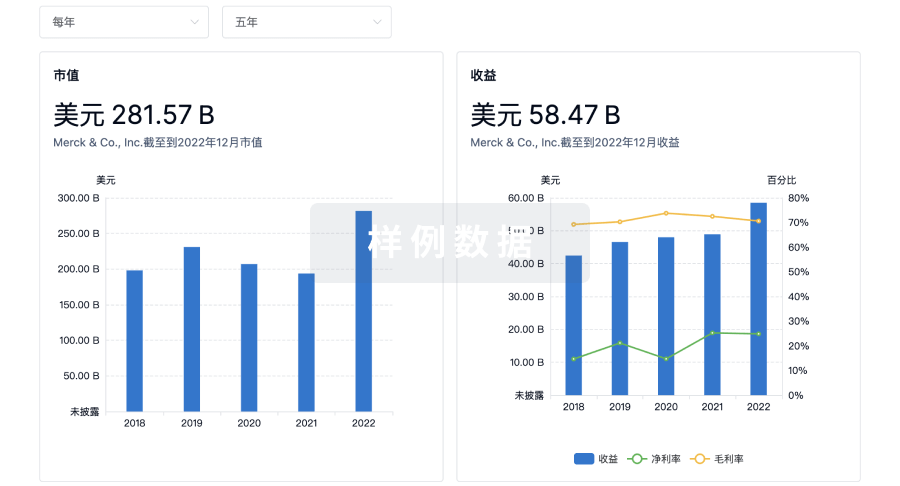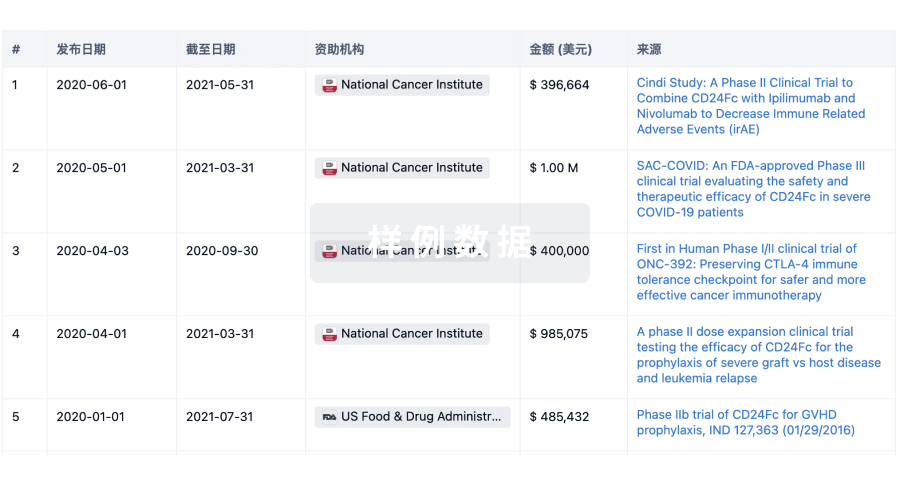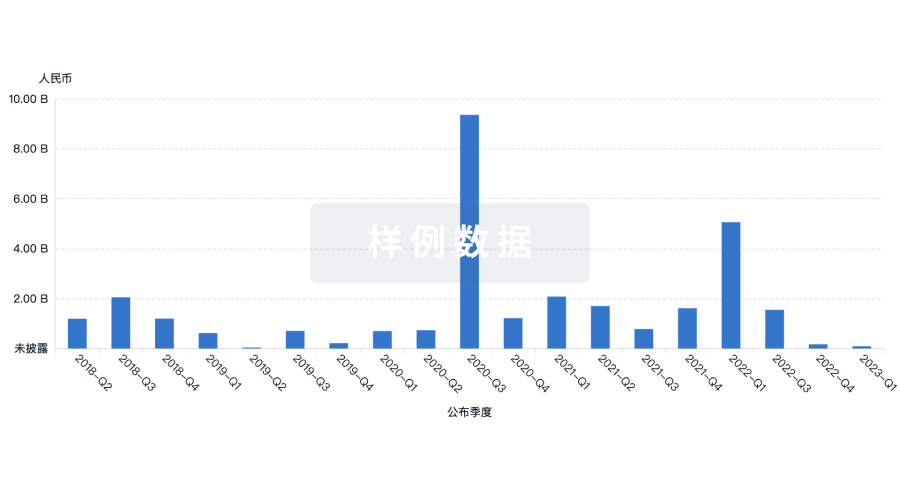预约演示
更新于:2025-05-07

Keimyung University
更新于:2025-05-07
概览
标签
消化系统疾病
肿瘤
泌尿生殖系统疾病
小分子化药
ADC
疾病领域得分
一眼洞穿机构专注的疾病领域
暂无数据
技术平台
公司药物应用最多的技术
暂无数据
靶点
公司最常开发的靶点
暂无数据
| 排名前五的药物类型 | 数量 |
|---|---|
| 小分子化药 | 2 |
| ADC | 1 |
| 排名前五的靶点 | 数量 |
|---|---|
| CTNNB1(连环素β1) | 1 |
| PDL1 x Top II | 1 |
| E2F1 x MUC4 x PTEN | 1 |
关联
4
项与 Keimyung University 相关的药物作用机制 PDL1抑制剂 [+1] |
在研适应症 |
非在研适应症- |
最高研发阶段临床前 |
首次获批国家/地区- |
首次获批日期- |
靶点 |
作用机制 CTNNB1抑制剂 |
非在研适应症- |
最高研发阶段临床前 |
首次获批国家/地区- |
首次获批日期- |
作用机制 E2F1抑制剂 [+2] |
非在研适应症 |
最高研发阶段临床前 |
首次获批国家/地区- |
首次获批日期- |
197
项与 Keimyung University 相关的临床试验NCT06618638
Clinical Trial for Shared Decision Making Model for Choosing Pharmacotherapy in ADPKD Patients
The purpose of this study is to generate clinical evidence and assess the feasibility of a shared decision-making (SDM) model for the selection of Tolvaptan in patients with ADPKD.
开始日期2024-10-21 |
申办/合作机构 |
NCT06471907
Comparison of Pain Relief and Peripheral Perfusion Index Using Different Volume of Erector Spinae Plane Block
The primary endpoint of this study is to compare the pain relief and peripheral perfusion index using different volume of local anesthetics in erector spinae plane block.
开始日期2024-06-13 |
NCT06779695
Prediction of Systemic Thromboembolism and Bleeding in Atrial Fibrillation Patients With Factor Xa Inhibitor (Apixaban, Rivaroxaban) by Echocardiographic Parameters: Prospective Observational Study (AF-ECHO Study)
Patients taking Factor Xa inhibitors (Apixaban, Rivaroxaban) in atrial fibrillation will be conducted a follow-up investigation on systemic embolism and bleeding events.
开始日期2024-04-21 |
申办/合作机构 |
100 项与 Keimyung University 相关的临床结果
登录后查看更多信息
0 项与 Keimyung University 相关的专利(医药)
登录后查看更多信息
11,344
项与 Keimyung University 相关的文献(医药)2025-09-01·Journal of Urban Planning and Development
Student Loans and Housing Behaviors: Evidence from South Korea
作者: Kim, Jinyhup
2025-07-01·Food Chemistry
Quercetin-loaded candelilla wax/sunflower oil oleogels: Structural, sensory, and storage properties, and application as fat replacer in emulsion-type sausage
Article
作者: Shin, Dong-Min ; Han, Jong Hyeon ; Lee, Hyun Ju ; Kothuri, Vahinika ; Keum, Dong Hyun ; Han, Sung Gu
2025-07-01·Applied Ergonomics
Effects of postural loading during static posture holding on concurrent executive function task performance
Article
作者: Moon, Philjun ; Jeong, Haeseok ; Han, Doo Won ; Park, Woojin ; Jeong, Yihun
6
项与 Keimyung University 相关的新闻(医药)2025-02-07
More than 90% of Omvoh-treated patients who were in clinical remission at one year sustained it with two years of continuous treatment
Nearly 90% of patients who achieved endoscopic response at one year sustained it at two years
Omvoh is the first IL-23p19 antagonist to demonstrate multi-year, sustained efficacy and safety for both Crohn's disease and ulcerative colitis
INDIANAPOLIS, Feb. 7, 2025 /PRNewswire/ -- Eli Lilly and Company (NYSE: LLY) announced results from the VIVID-2 open-label extension study, which showed the majority of patients with moderately to severely active Crohn's disease receiving two years of continuous treatment with Omvoh® (mirikizumab-mrkz) achieved long-term clinical and endoscopic outcomes, including those (43.8%) with previous biologic failure. Data from this study will be presented at the Crohn's and Colitis Congress (CCC), being held from February 6-8, 2025 in San Francisco.1
Omvoh works to reduce inflammation within the gastrointestinal tract by targeting a specific protein, interleukin-23p19 (IL-23p19), which is a key contributor to intestinal inflammation.2,3
"Many people living with Crohn's disease have tried available therapies without success or have experienced a loss of efficacy with their treatment," said Edward Barnes, M.D., MPH, Associate Professor of Medicine in the Division of Gastroenterology & Hepatology, Co-Director of the Multidisciplinary Inflammatory Bowel Diseases Center at the University of North Carolina at Chapel Hill. "These positive, multi-year data can give health care providers confidence that Omvoh may help their patients achieve and maintain long-term outcomes, including intestinal healing."
Participants randomized to Omvoh in the Phase 3 VIVID-1 study who achieved endoscopic response after one year of treatment continued Omvoh maintenance treatment in VIVID-2. The following results were achieved based upon observed case analysis after two years of continuous treatment, including one year during VIVID-1:
Among patients who were in clinical remission at one year in VIVID-1, 92.9% maintained clinical remission at two years as measured by Crohn's Disease Activity Index (CDAI).
Among patients treated in VIVID-2, 87.6% maintained endoscopic response, defined by visible healing of the intestinal lining and measured by a ≥50% reduction from baseline in Simple Endoscopic Score for Crohn's Disease (SES-CD) total score.
Among patients who were in endoscopic remission at one year of treatment in VIVID-1, 78.6% maintained endoscopic remission at two years as measured by SES-CD ≤4 and ≥2-point reduction from baseline, with no subscore >1 in any individual variable.1
Additionally:
Among patients who were not in clinical remission by CDAI at one year, 60.8% gained clinical remission during the second year of treatment.
Among patients who were not in endoscopic remission at one year, 35.4% gained endoscopic remission during the second year of treatment.1
These results were also evaluated using a modified non-responder imputation method, presented in the About the VIVID Clinical Trial Program section below.
In VIVID-2, the long-term safety profile of Omvoh in patients with moderately to severely active Crohn's disease was generally consistent with the known safety profile of Omvoh. During the second year of continuous treatment with Omvoh, 6.8% of patients with endoscopic response at one year reported a serious adverse event and 0.8% discontinued treatment due to an adverse event.1
"Lilly is setting a high bar for sustained and durable treatment response for patients living with the profound impact of inflammatory bowel disease," said Mark Genovese, M.D., senior vice president of Lilly Immunology development. "These results build on the body of evidence that demonstrates Omvoh's ability to provide early meaningful improvement and long-term disease control with strong clinical, endoscopic and histologic outcomes."
Omvoh was approved by the United States Food and Drug Administration (FDA) for the treatment of moderately to severely active Crohn's disease in adults in January 2025. In December 2024, the European Medicines Agency's (EMA) Committee for Medicinal Products for Human Use (CHMP) issued a positive opinion for Omvoh for the treatment of adults with moderately to severely active Crohn's disease. Lilly has submitted marketing applications around the globe, including in Canada, Japan and China, with additional global regulatory submissions planned. Omvoh is also approved in 44 countries for the treatment of moderately to severely active ulcerative colitis (UC) in adults.
Omvoh is the first and only IL-23p19 antagonist to demonstrate long-term, multi-year, sustained efficacy and safety for both Crohn's disease and UC.
Omvoh has additional ongoing trials in Crohn's disease and UC, including studies to evaluate the long-term efficacy and safety of Omvoh in pediatric patients and adults, and a Phase 4 real-world evidence study to evaluate Omvoh's impact in patients with UC in clinical practice.
About the VIVID Clinical Trial Program
VIVID-1 was a Phase 3 randomized, double-blind, placebo-controlled 52-week study in adults with moderately to severely active Crohn's disease. Patients randomized to Omvoh received Omvoh 900mg by intravenous (IV) infusion at Week 0, Week 4 and Week 8 followed by a maintenance dose of 300mg by subcutaneous injection (SC) at Week 12 and then every 4 weeks (Q4W) for 40 weeks.2
Participants who completed VIVID-1, including the Week 52 endoscopy, were eligible for VIVID-2. In VIVID-2, the primary objective is to evaluate the long-term effect of Omvoh in clinical remission by CDAI and endoscopic response at Week 52 of treatment in VIVID-2 (totaling 104 weeks of continuous treatment). Safety is being assessed from the first dose in VIVID-2.1
Using a modified non-responder imputation method, among Omvoh endoscopic responders at year one, 81.8% maintained endoscopic response at two years, 86.9% maintained clinical remission at two years, and 72.5% maintained endoscopic remission at two years.1
About Omvoh®
Omvoh® (mirikizumab-mkrz) is an interleukin-23p19 antagonist indicated for the treatment of moderately to severely active ulcerative colitis and Crohn's disease in adults. Omvoh selectively targets the p19 subunit of IL-23 and inhibits the IL-23 pathway. Inflammation due to over-activation of the IL-23 pathway plays a critical role in the pathogenesis of inflammatory bowel disease.4
Omvoh® and its delivery device base are trademarks owned by Eli Lilly and Company.
Indications and Usage for Omvoh®
(mirikizumab-mrkz) (in the United States)
Omvoh is an interleukin-23 antagonist indicated for adults with:
Moderately to severely active ulcerative colitis
Moderately to severely active Crohn's disease
Important Safety Information for Omvoh (mirikizumab-mrkz)
CONTRAINDICATIONS
Omvoh is contraindicated in patients with a history of serious hypersensitivity reaction to mirikizumab-mrkz or any of the excipients.
WARNINGS AND PRECAUTIONS
Hypersensitivity Reactions
Serious hypersensitivity reactions, including anaphylaxis during intravenous infusion, have been reported with Omvoh administration. Infusion-related hypersensitivity reactions, including mucocutaneous erythema and pruritus, were reported during induction. If a severe hypersensitivity reaction occurs, discontinue Omvoh immediately and initiate appropriate treatment.
Infections
Omvoh may increase the risk of infection. Do not initiate treatment with Omvoh in patients with a clinically important active infection until the infection resolves or is adequately treated. In patients with a chronic infection or a history of recurrent infection, consider the risks and benefits prior to prescribing Omvoh. Instruct patients to seek medical advice if signs or symptoms of clinically important acute or chronic infection occur. If a serious infection develops or an infection is not responding to standard therapy, monitor the patient closely and do not administer Omvoh until the infection resolves.
Tuberculosis
Evaluate patients for tuberculosis (TB) infection prior to initiating treatment with Omvoh. Do not administer Omvoh to patients with active TB infection. Initiate treatment of latent TB prior to administering Omvoh. Consider anti-TB therapy prior to initiation of Omvoh in patients with a history of latent or active TB in whom an adequate course of treatment cannot be confirmed. Monitor patients for signs and symptoms of active TB during and after Omvoh treatment. In clinical trials, subjects were excluded if they had evidence of active TB, a history of active TB, or were diagnosed with latent TB at screening.
Hepatotoxicity
Drug-induced liver injury in conjunction with pruritus was reported in a clinical trial subject following a longer than recommended induction regimen. Omvoh was discontinued. Liver test abnormalities eventually returned to baseline. Evaluate liver enzymes and bilirubin at baseline and for at least 24 weeks of treatment. Monitor thereafter according to routine patient management. Consider other treatment options in patients with evidence of liver cirrhosis. Prompt investigation of the cause of liver enzyme elevation is recommended to identify potential cases of drug-induced liver injury. Interrupt treatment if drug-induced liver injury is suspected, until this diagnosis is excluded. Instruct patients to seek immediate medical attention if they experience symptoms suggestive of hepatic dysfunction.
Immunizations
Avoid use of live vaccines in patients treated with Omvoh. Medications that interact with the immune system may increase the risk of infection following administration of live vaccines. Prior to initiating therapy, complete all age-appropriate vaccinations according to current immunization guidelines. No data are available on the response to live or non-live vaccines in patients treated with Omvoh.
ADVERSE REACTIONS
Most common adverse reactions associated with Omvoh (≥2% of subjects and at a higher frequency than placebo) in ulcerative colitis treatment are upper respiratory tract infections and arthralgia during the induction study (UC-1), and upper respiratory tract infections, injection site reactions, arthralgia, rash, headache, and herpes viral infection during the maintenance study (UC-2). Most common adverse reactions associated with Omvoh in the Crohn's disease study (CD-1) (≥5% of subjects and at a higher frequency than placebo) are upper respiratory tract infections, injection site reactions, headache, arthralgia, and elevated liver tests.
Omvoh injection is available as a 300 mg/15 mL solution in a single-dose vial for intravenous infusion, and as a 100 mg/mL solution or a 200 mg/2 mL solution in a single dose prefilled pen or prefilled syringe for subcutaneous injection. Refer to the Prescribing Information for dosing information.
MR HCP ISI CD APP
Click to access provided
Prescribing Information
and
Medication Guide
. See Instructions for Use provided with the device.
About Lilly
Lilly is a medicine company turning science into healing to make life better for people around the world. We've been pioneering life-changing discoveries for nearly 150 years, and today our medicines help tens of millions of people across the globe. Harnessing the power of biotechnology, chemistry and genetic medicine, our scientists are urgently advancing new discoveries to solve some of the world's most significant health challenges: redefining diabetes care; treating obesity and curtailing its most devastating long-term effects; advancing the fight against Alzheimer's disease; providing solutions to some of the most debilitating immune system disorders; and transforming the most difficult-to-treat cancers into manageable diseases. With each step toward a healthier world, we're motivated by one thing: making life better for millions more people. That includes delivering innovative clinical trials that reflect the diversity of our world and working to ensure our medicines are accessible and affordable. To learn more, visit Lilly.com and Lilly.com/news, or follow us on Facebook, Instagram, and LinkedIn. P-LLY
Cautionary Statement Regarding Forward-Looking Statements
This press release contains forward-looking statements (as that term is defined in the Private Securities Litigation Reform Act of 1995) about Omvoh (mirikizumab-mrkz) as a treatment for people with moderate to severe Crohn's disease and reflects Lilly's current beliefs and expectations. However, as with any pharmaceutical product, there are substantial risks and uncertainties in the process of drug research, development, and commercialization. Among other things, there is no guarantee that planned or ongoing studies will be completed as planned, that future study results will be consistent with study results to date, that Omvoh will receive additional regulatory approvals, or that Omvoh will be commercially successful. For further discussion of these and other risks and uncertainties that could cause actual results to differ from Lilly's expectations, see Lilly's Form 10-K and Form 10-Q filings with the United States Securities and Exchange Commission. Except as required by law, Lilly undertakes no duty to update forward-looking statements to reflect events after the date of this release.
References
1 Barnes, EL, et al. Long-term efficacy and safety of mirikizumab following 104 weeks of continuous treatment for Crohn's Disease: results from the VIVID-2 open-label extension study. 2025 Crohn's and Colitis Congress. February 6-8, 2025.
2 Ferrante M, et al. Efficacy and safety of mirikizumab in patients with moderately-to-severely active Crohn's disease: a phase 3, multicentre, randomised, double-blind, placebo-controlled and active-controlled, treat-through study. The Lancet. 2024;404(10470):2423-2436.
3 Chang JT. Pathophysiology of inflammatory bowel diseases. N Engl J Med. 2020 Dec 31;383(27):2652-2664. doi: 10.1056/NEJMra2002697. PMID: 33382932.
4 Omvoh. Prescribing Information. Lilly USA, LLC.
SOURCE Eli Lilly and Company
WANT YOUR COMPANY'S NEWS FEATURED ON PRNEWSWIRE.COM?
440k+
Newsrooms &
Influencers
9k+
Digital Media
Outlets
270k+
Journalists
Opted In
GET STARTED
临床结果临床3期上市批准临床2期
2025-01-15
Improved overall survival (OS), progression-free survival (PFS) and confirmed objective response rate (ORR) were observed in the China subpopulation treated with TIVDAK compared to chemotherapy, consistent with those in the global population The safety profile of TIVDAK among the China subpopulation was manageable and consistent with that observed in the global population Zai Lab intends to submit a New Drug Application (NDA) to China’s National Medical Products Administration (NMPA) in the first quarter of 2025 Zai Lab will leverage its commercial footprint of ZEJULA in women’s cancer to bring the medicine to patients in China if approved
SHANGHAI & CAMBRIDGE, Mass.--(BUSINESS WIRE)--Jan. 15, 2025-- Zai Lab Limited (NASDAQ: ZLAB; HKEX: 9688) today announced positive topline results from the China subpopulation of the global Phase 3 innovaTV 301 study, demonstrating a clinically meaningful improvement in overall survival with TIVDAK treatment for patients with previously treated recurrent or metastatic cervical cancer compared to chemotherapy.
The China subpopulation results were consistent with those in the global population:
TIVDAK demonstrated a 45% reduction in the risk of death compared to chemotherapy (HR: 0.55 [95% CI: 0.27-1.15] in the China subpopulation who had received prior standard systemic therapies, with more than half of this Chinese population having received prior anti-PD(L)1 therapy. Median OS for patients treated with TIVDAK was not reached versus chemotherapy 10.7 months [95% CI: 6.0-not reached] with a median follow-up of 11.5 months. Secondary endpoints of PFS and confirmed ORR also favored treatment with TIVDAK compared to chemotherapy. The safety profile of TIVDAK in the China subpopulation was manageable and consistent with the global profile.
“Recurrent or metastatic cervical cancer remains a significant challenge for patients, highlighting a critical unmet need for effective treatments that extend survival after relapse,” said Dr. Rafael Amado, M.D., President, Head of Global Research and Development at Zai Lab. “The consistent and positive results in the China subpopulation of the global Phase 3 study reinforce the potential for TIVDAK, the only ADC therapy in this disease setting, to increase options in this therapeutically unmet clinical setting. If approved, we expect TIVDAK to add to ZEJULA and augment our commercial franchise in women’s tumors.”
“There are approximately 150,000 new cases of cervical cancer annually in China1, and patients face limited treatment options once their cancer recurs or spreads after initial treatment,” said Dr. Lingying Wu, Professor of the Department of Gynecologic Oncology of National Cancer Center / Cancer Hospital Chinese Academy of Medical Sciences. “While the recent adoption of immunotherapy as a first-line treatment in China represents progress, there is a lack of effective options for patients following relapse. The promising results from TIVDAK, which demonstrated superior survival extension in patients whose disease progressed after initial treatments, including prior anti-PD(L)1 treatment, offer hope for addressing this critical unmet need.”
In April 2024, the U.S. Food and Drug Administration (FDA) approved the supplemental Biologics License Application (sBLA) granting full approval for TIVDAK® (tisotumab vedotin-tftv) for the treatment of patients with recurrent or metastatic cervical cancer with disease progression on or after chemotherapy. The approval was based on results from the global, randomized, Phase 3 innovaTV 301 clinical trial (NCT04697628), which met its primary endpoint, demonstrating overall survival (OS) benefit in adult patients with previously treated recurrent or metastatic cervical cancer treated with TIVDAK compared to chemotherapy.
TIVDAK demonstrated a 30% reduction in the risk of death compared to chemotherapy (hazard ratio [HR]: 0.70 [95% CI: 0.54-0.89], two-sided p=0.0038)2. Median OS for patients treated with TIVDAK was 11.5 months [95% CI: 9.8-14.9] versus chemotherapy 9.5 months [95% CI: 7.9-10.7]. PFS and confirmed ORR were also significantly improved compared to chemotherapy. The safety profile of TIVDAK was consistent with its known safety profile as presented in the U.S. prescribing information, and no new safety signals were observed.
Based on these encouraging results, Zai Lab intends to submit an NDA for TIVDAK to China’s National Medical Products Administration (NMPA) in the first quarter of 2025. The full China subpopulation data will be presented at a future medical conference in 2025.
About innovaTV 301 Trial Design
The innovaTV 301 trial (NCT04697628) is a global, 1:1 randomized, open-label Phase 3 trial evaluating TIVDAK® (tisotumab vedotin) versus investigator’s choice of single agent chemotherapy (topotecan, vinorelbine, gemcitabine, irinotecan, or pemetrexed) with recurrent or metastatic cervical cancer who received chemotherapy.
Patients with recurrent or metastatic cervical cancer with squamous cell, adenocarcinoma, or adenosquamous histology, and disease progression during or after treatment with chemotherapy doublet +/- bevacizumab and an anti-PD-(L)1 agent (if eligible) are included. The primary endpoint was overall survival. The main secondary outcomes were progression-free survival and objective response rate.
The study was conducted by Seagen, which was acquired by Pfizer in December 2023, in collaboration with Genmab, European Network of Gynaecological Oncological Trial Groups (ENGOT, study number ENGOT cx-12) and the Gynecologic Oncology Group (GOG) Foundation (study number GOG 3057), as well as other global gynecological oncology cooperative groups.
For more information about the Phase 3 innovaTV 301 clinical trial and other clinical trials with tisotumab vedotin, please visit www.clinicaltrials.gov.
About Cervical Cancer in China
Cervical cancer remains one of the leading causes of cancer death in women in China and globally. An estimated 150,000 new cases of cervical cancer occur annually in China1. Current treatment options are limited for patients with recurrent or metastatic cervical cancer with disease progression on or after systemic therapy. TIVDAK is well positioned to provide a new option for previously treated advanced cervical cancer patients who currently have limited treatment options and poor outcomes.
About TIVDAK® (tisotumab vedotin)
TIVDAK® (tisotumab vedotin) is an antibody-drug conjugate (ADC) composed of Genmab’s human monoclonal antibody directed to tissue factor (TF) and Pfizer’s ADC technology that utilizes a protease-cleavable linker that covalently attaches the microtubule-disrupting agent monomethyl auristatin E (MMAE) to the antibody. Nonclinical data suggest that the anticancer activity of tisotumab vedotin is due to the binding of the ADC to TF-expressing cancer cells, followed by internalization of the ADC-TF complex, and release of MMAE via proteolytic cleavage. MMAE disrupts the microtubule network of actively dividing cells, leading to cell cycle arrest and apoptotic cell death. In vitro, tisotumab vedotin also mediates antibody-dependent cellular phagocytosis and antibody-dependent cellular cytotoxicity.
TIVDAK received accelerated approval from the FDA in September 2021 and full approval in April 2024 for adult patients with recurrent or metastatic cervical cancer with disease progression on or after chemotherapy.
Please see full prescribing information, including BOXED WARNING for TIVDAK here.
Zai Lab has an exclusive license from Seagen Inc., a company later acquired by Pfizer, to develop and commercialize TIVDAK in Greater China (mainland China, Hong Kong, Macau, and Taiwan, collectively).
About Zai Lab
Zai Lab (NASDAQ: ZLAB; HKEX: 9688) is an innovative, research-based, commercial-stage biopharmaceutical company based in China and the United States. We are focused on discovering, developing, and commercializing innovative products that address medical conditions with significant unmet needs in the areas of oncology, immunology, neuroscience and infectious disease. Our goal is to leverage our competencies and resources to positively impact human health worldwide.
For additional information about Zai Lab, please visit www.zailaboratory.com or follow us at www.twitter.com/ZaiLab_Global.
Zai Lab Forward-Looking Statements
This press release contains forward-looking statements relating to our future expectations, plans, and prospects, including, without limitation, statements relating to our prospects and plans for developing and commercializing TIVDAK in Greater China, the potential benefits of TIVDAK, and the potential treatment of cervical cancer. These forward-looking statements may contain words such as “aim,” “anticipate,” “believe,” “could,” “estimate,” “expect,” “forecast,” “goal,” “intend,” “may,” “plan,” “possible,” “potential,” “will,” “would,” and other similar expressions. Such statements constitute forward-looking statements within the meaning of the Private Securities Litigation Reform Act of 1995. Forward-looking statements are not statements of historical fact or guarantees or assurances of future performance. Forward-looking statements are based on our expectations and assumptions as of the date of this press release and are subject to inherent uncertainties, risks, and changes in circumstances that may differ materially from those contemplated by the forward-looking statements. Actual results may differ materially from those indicated by such forward-looking statements as a result of various important factors, including but not limited to (1) our ability to successfully commercialize and generate revenue from our approved products, (2) our ability to obtain funding for our operations and business decisions, (3) the results of our clinical and pre-clinical development of our product candidates, (4) the content and timing of decisions made by the relevant regulatory authorities regarding regulatory approvals of our product candidates, (5) risks related to doing business in China, and (6) other factors identified in our most recent annual and quarterly reports and in other reports we have filed with the U.S. Securities and Exchange Commission. We anticipate that subsequent events and developments will cause our expectations and assumptions to change, and we undertake no obligation to update or revise any forward-looking statements, whether as a result of new information, future events, or otherwise, except as may be required by law. These forward-looking statements should not be relied upon as representing our views as of any date subsequent to the date of this press release.
Our SEC filings can be found on our website at www.zailaboratory.com and the SEC’s website at www.sec.gov.
Notes: 1 Bingfeng Han et al., "Cancer incidence and mortality in China, 2022" Journal of the National Cancer Center, 2024. DOI: 10.1016/j.jncc.2024.01.006. 2 The threshold for statistical significance is 0.0226 (2-sided).
View source version on businesswire.com: https://www.businesswire.com/news/home/20250115437262/en/
Investor Relations: Christine Chiou / Lina Zhang +1 (917) 886-6929 / +86 136 8257 6943 christine.chiou1@zailaboratory.com / lina.zhang@zailaboratory.com
Media: Shaun Maccoun / Xiaoyu Chen +1 (857) 270-8854 / +86 185 0015 5011 shaun.maccoun@zailaboratory.com / xiaoyu.chen@zailaboratory.com
Source: Zai Lab Limited
临床3期临床结果上市批准引进/卖出免疫疗法
2024-11-27
TAICHUNG, Nov. 27, 2024 /PRNewswire/ -- In HIMSS24 APAC Seoul, Healthcare Conference & Exhibition, China Medical University Hospital (CMUH) established international presence with four notable gradings: achieving the top score in the 2023 HIMSS Global Digital Health Indicator (DHI) and receiving prestigious certifications, including Infrastructure Adoption Model (INFRAM) Stage 7, Analytics Maturity Assessment Model (AMAM) Stage 6, and Digital Imaging Adoption Model (DIAM) Stage 6. This demonstrates the excellence of CMUH in smart healthcare practice and further improvement of quality patient care.
Continue Reading
The Taiwan CMUH team attended HIMSS24 APAC Seoul to receive prestigious certifications. CMUH will continue advancing smart healthcare by integrating global technologies to deliver innovative treatments and improve patient care.
Leading Way to Smart Healthcare 4.0 – Enhancing Patient Care Through Digitalization
Under the leadership of CMUH's Superintendent Der-Yang Cho, CMUH has pioneered healthcare digitalization and has achieved notable international certifications. Superintendent Cho stated that CMUH is embracing "Smart Healthcare 4.0," which includes the development of novel mRNA-based CAR-T immunotherapy powered by AI-driven Drug Discovery, and smart healthcare systems developed in collaboration with Microsoft and Google since 2020. These innovations include the "Medical Information Revise Assistant (MIRA)" and the "Side-effects Organizing Platform with Healthcare Intelligent Assistance (SOPHIA)," designed to provide individualized smart healthcare. These advancements not only reduce the workload of healthcare professionals in CMUH but also ensure the best quality of care for patients.
Personnel, Process and Technology Development in Parallel as the Key to Digital Healthcare
CMUH established the Taiwan Smart Healthcare Pavilion to showcase "HiThings Tele-ICU," which highlights three notable smart healthcare platforms: the Intelligent Anti-Microbial System (i.A.M.S.) for sepsis and drug resistance infection, the Smart Heart Platform for acute myocardial infarction, and ARDiTeX for acute respiratory distress syndrome. These platforms enable comprehensive monitoring and care in critical care settings, collectively reducing nursing personnel's workload by more than
5,000 hours. According to Director Wen-Sheng Feng of the Digital Transformation Technology Office at CMUH, the system provides real-time monitoring of patients' physiological data and is useful in discovering the high-risk patients of acute respiratory distress syndrome. Supported by AI algorithms, the system sends timely notifications, ensuring prompt care and effectively reducing mortality rates by 18.9%. CMUH's Chief Secretary, Dr. Wei-Cheng Chen, highlighted that AI-driven predictions and integrated information systems empower physicians to analyze large datasets efficiently and coordinate timely interventions with multidisciplinary teams, ensuring optimal, personalized care for each patient.
Overcoming Challenges in Data Integration and Interoperability to Propel Smart Healthcare Development
Dr. Shih-Sheng Chang, Director of CMUH's AI Center, and Prof. Chi-Heum Cho, Vice Superintendent of Keimyung University Dongsan Medical Center, discussed over "The Power of Data in Modern Healthcare." Dr. Chang emphasized that data integration and interoperability remain key challenges in advancing smart healthcare. He highlighted that individualized nursing, wearable devices for real-time data collection, and AI-assisted remote surgeries are critical dimensions for unlocking the full potential of healthcare data. Dr. Chang also underscored the importance of multidisciplinary and cross-border collaborations in driving progress in this field. Meanwhile, Prof. Cho shared insights from South Korea, where a resident doctors' strike prompted hospitals to fully adopt smart technologies, including robotic delivery systems and smart operating rooms. These advancements have significantly enhanced operational efficiency and patient care.
With the acquisition of EMRAM Stage 7 re-certification, INFRAM Stage 7, AMAM Stage 6, and DIAM Stage 6 certifications, CMUH positions as a leading digital healthcare provider among Taiwan-based institutions. CMUH remains committed to fostering cross-border collaborations and enhancing patient care through the advanced application of data and AI technology. By embracing highly accurate smart healthcare solutions, CMUH continues to realize its vision of "patient-centered" care.
CONTACT: Carolyn Chen, [email protected]
SOURCE China Medical University Hospital
WANT YOUR COMPANY'S NEWS FEATURED ON PRNEWSWIRE.COM?
440k+
Newsrooms &
Influencers
9k+
Digital Media
Outlets
270k+
Journalists
Opted In
GET STARTED
并购
100 项与 Keimyung University 相关的药物交易
登录后查看更多信息
100 项与 Keimyung University 相关的转化医学
登录后查看更多信息
组织架构
使用我们的机构树数据加速您的研究。
登录
或

管线布局
2025年10月13日管线快照
管线布局中药物为当前组织机构及其子机构作为药物机构进行统计,早期临床1期并入临床1期,临床1/2期并入临床2期,临床2/3期并入临床3期
临床前
3
1
其他
登录后查看更多信息
当前项目
| 药物(靶点) | 适应症 | 全球最高研发状态 |
|---|---|---|
百里香醌 ( E2F1 x MUC4 x PTEN ) | 肾肿瘤 更多 | 临床前 |
PD-L1-AuNP-DOX ( PDL1 x Top II ) | 结直肠癌 更多 | 临床前 |
CWP232228 ( CTNNB1 ) | 结肠癌 更多 | 临床前 |
KMU-3 ( CEBPB x FASN x PPARα/γ x STMN3 ) | 肥胖 更多 | 无进展 |
登录后查看更多信息
药物交易
使用我们的药物交易数据加速您的研究。
登录
或

转化医学
使用我们的转化医学数据加速您的研究。
登录
或

营收
使用 Synapse 探索超过 36 万个组织的财务状况。
登录
或

科研基金(NIH)
访问超过 200 万项资助和基金信息,以提升您的研究之旅。
登录
或

投资
深入了解从初创企业到成熟企业的最新公司投资动态。
登录
或

融资
发掘融资趋势以验证和推进您的投资机会。
登录
或

Eureka LS:
全新生物医药AI Agent 覆盖科研全链路,让突破性发现快人一步
立即开始免费试用!
智慧芽新药情报库是智慧芽专为生命科学人士构建的基于AI的创新药情报平台,助您全方位提升您的研发与决策效率。
立即开始数据试用!
智慧芽新药库数据也通过智慧芽数据服务平台,以API或者数据包形式对外开放,助您更加充分利用智慧芽新药情报信息。
生物序列数据库
生物药研发创新
免费使用
化学结构数据库
小分子化药研发创新
免费使用



